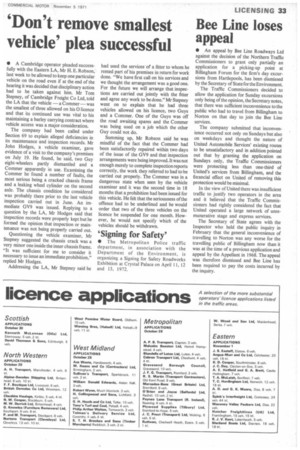'Don't remove smallest vehicle' plea successful
Page 35

If you've noticed an error in this article please click here to report it so we can fix it.
• A Cambridge operator pleaded successfully with the Eastern LA, Mr H. E. Robson, last week to be allowed to keep one particular vehicle on the road even if at the end of the hearing it was decided that disciplinary action had to be taken against him. Mr Tom Stepney, of Cambridge Freight Co Ltd, told the LA that the vehicle —a Commer — was the smallest of three allowed on his 0 licence and that its continued use was vital to his maintaining a barley carrying contract where vehicle access was a major consideration.
The company had been called under Section 69 to explain alleged deficiencies in its maintenance and inspection records. Mr John Hodges, a vehicle examiner, gave evidence of a visit to the company's premises on July 19. He found, he said, two Guy eight-wheelers partly dismantled and a Commer apparently in use. Examining the Commer he found a number of faults, the most serious being a cracked chassis frame and a leaking wheel cylinder on the second axle. The chassis condition he considered was probably there prior to the last vehicle inspection carried out in June. An immediate GV9 was issued. Replying to a question by the LA, Mr Hodges said that inspection records were properly kept but he formed the opinion that inspection or maintenance was not being properly carried out.
Questioning the vehicle examiner. Mr Stepney suggested the chassis crack was a very minor one inside the inner chassis frame. "It was sufficient for me to consider it necessary to issue an immediate prohibition," replied Mr Hodges.
Addressing the LA, Mr Stepney said he
had used the servicesof a fitter to whom he rented part of his premises in return for work done. "We have first call on his services and we thought the arrangement was a good one. For the future we will arrange that inspections are carried out jointly with the fitter and agree any work to be done.Mr Stepney went on to explain that he had three vehicles allowed on his licence, two Guys and a Commer. One of the Guys was off the road awaiting spares and the Commer was being used on a job which the other Guy could not do.
Summing up, Mr Robson said he was mindful of the fact that the Commer had been satisfactorily repaired within two days of the issue of the GV9 and that inspection arrangements were being improved. It was not enough merely to complete inspection reports correctly, the work they referred to had to be carried out properly. The Commer was in a dangerous state when seen by the vehicle examiner and it was the second time in 18 months that a prohibition had been issued for this vehicle. He felt that the seriousness of the offence had to be underlined and he would order that two of the three vehicles on the licence be suspended for one month. However, he would not specify which of the vehicles should be withdrawn.
'Signing for Safety'
• The Metropolitan Police traffic department. in association with the Department of the Environment, is organizing a Signing for Safety Roadworks Exhibition at Crystal Palace on April 11, 12 and 13, 1972.




































































































































































